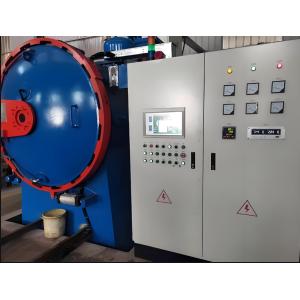

Add to Cart
A vacuum furnace is a sophisticated industrial device that performs heat treatments in a controlled vacuum environment, crucial for minimizing oxidation, contamination, and thermal distortion of materials. The furnace’s advanced monitoring and control capabilities make it highly versatile for applications in industries where high-quality, precise material processing is essential, such as aerospace, medical equipment, and electronics.
The primary components of a vacuum furnace include:
1. Heating Chamber: Houses materials for treatment. This chamber is equipped with heating elements, often made from graphite or tungsten, to sustain high temperatures.
2. Vacuum System: Consists of pumps and valves to maintain a vacuum or controlled atmosphere, crucial for purity in processes.
3. Cooling System: Uses cooling gases like argon or nitrogen to lower temperatures gradually after treatment, preventing thermal shock.
4. Control and Monitoring System: Incorporates sensors and computerized controls to adjust temperature, pressure, and cooling rates, ensuring consistency and precision across the treatment process.
5. Loading and Unloading Mechanism: Minimizes contamination risk by allowing materials to be handled in a controlled environment.
1. Versatility in Material Processing: Vacuum furnaces accommodate various materials—metals, ceramics, and alloys—providing a broad range of heat treatments like annealing, brazing, and hardening.
2. Advanced Monitoring and Control: Integrated sensors and digital systems allow precise adjustments to temperature, pressure, and timing, ensuring highly accurate outcomes for critical applications.
3. High Purity and Cleanliness: The vacuum environment reduces contamination from air, moisture, and gases, making the furnace ideal for high-purity applications.
4. Uniform Heating: Even heat distribution reduces thermal distortion, resulting in uniform treatment, critical for materials requiring structural integrity.
5. Environmentally Friendly Operation: The sealed vacuum system reduces emissions, making it a cleaner alternative to open furnaces.
1. Aerospace and Defense: Ideal for treating high-performance alloys and metals like titanium, used in aircraft and defense components where durability and lightweight properties are crucial.
2. Medical Industry: Suitable for processing biocompatible metals like titanium and cobalt-chrome, which are used in surgical implants and medical devices.
3. Electronics and Semiconductors: Used in the manufacture of high-purity silicon wafers and semiconductor components requiring exact thermal management.
4. Tool Manufacturing: For hardening and tempering high-strength cutting tools and dies, extending their wear resistance and operational life.
5. Automotive Industry: In heat-treating components like gears, which require specific hardness and durability for optimal performance.
1. What temperature ranges can vacuum furnaces handle?
Most vacuum furnaces operate from around 1000°C to 2000°C,
depending on the materials and processes involved.
2. How is the vacuum achieved and maintained?
A combination of rotary, diffusion, and turbo pumps ensures and
maintains the vacuum environment within the furnace chamber.
3. Can a vacuum furnace be used for non-metals?
Yes, vacuum furnaces can process various materials, including
ceramics and high-purity materials beyond metals.
4. Is regular maintenance required for a vacuum furnace?
Yes, routine maintenance, such as checking seals, pumps, and
heating elements, is essential to maintain optimal performance.
5. Why are vacuum furnaces favored in high-purity applications?
The vacuum environment prevents oxidation and contamination,
ensuring high-purity outcomes, essential in applications like
aerospace and electronics.
Vacuum furnaces represent a pinnacle of precision, versatility, and control in material processing. Their advanced monitoring systems, versatile applications, and capacity for high-purity outcomes make them indispensable in industries requiring reliable, contamination-free heat treatment. This technology's adaptability and precision ensure it will continue to be a key asset in the advancement of material sciences and high-performance manufacturing.
